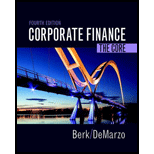
You are an analyst working for Goldman Sachs, and you are trying to value the growth potential of a large, established company, Big Industries. Big Industries has a thriving R&D division that has consistently turned out successful products. You estimate that, on average, the R&D division generates two new product proposals every three years, so that there is a two-thirds chance that a project will be proposed every year. Typically, the investment opportunities the R&D division produces require an initial investment of $10 million and yield profits of $1 million per year that grow at one of three possible growth rates in perpetuity: 3%, 0%, and –3%. All three growth rates are equally likely for any given project. These opportunities are always “take it or leave it” opportunities: If they are not undertaken immediately, they disappear forever. Assume that the cost of capital will always remain at 12% per year. What is the
Want to see the full answer?
Check out a sample textbook solution
Chapter 22 Solutions
Corporate Finance: The Core (4th Edition) (Berk, DeMarzo & Harford, The Corporate Finance Series)
- Wizzy Wigs is an unleveraged firm with $80 million in total assets, 2 million shares outstanding, and $15 million in EBIT. The shares price is $40, tax adjusted cost of debt 4.61%, and corporate tax rate of 21%. What are the returns on equity (ROEs) for the firm if it shifts to a 0.75 debt-to-equity ratio and for an individual with 700 shares who created homemade leverage at the same DE ratio? ◻ firm 25.61%; inv. 24.99% firm 18.24%; inv. 19.46% firm 38.59%; inv. 35.53% firm 23.19%; inv. 22.46% firm 30.07%; inv. 30.19% Please show work on excel spreadsheetarrow_forwardYou are running a hot Internet company. Analysts predict that its earnings will grow at 20% per year for the next 9 years. After that, as competition increases, earnings growth is expected to slow to 4% per year and continue at that level forever. Your company has just announced earnings of $4 million. What is the present value of all future earnings if the interest rate is 9%? (Assume all cash flows occur at the end of the year.) The present value of all future earnings is million. (Round to two decimal places.)arrow_forward3. Losses for an insurance company next year are estimated to be 100 million with standard deviation 250 million. Using lognormal and two-parameter Pareto distributions to obtain the VaR at the 95%, 97.5%, 99% security levels. Comment on your findings.arrow_forward
- A company sold 4 million shares in its IPO, at a priceof $18.50 per share. Management negotiated a fee(the underwriting spread) of 7% on this transaction.What was the dollar cost of this fee?arrow_forwardConsider the following three bonds (see Table 1), which all have a par value of $100 and pay coupons semiannually if the coupon rate is not zero. What is the 6.5-year spot rate on a BEY basis? Bond Coupon Rate Price Maturity(yrs) A 106 3 6 75 B 0 6 115 C 4 6.5arrow_forwardProblem 6-8 Project Evaluation Dog Up! Franks is looking at a new sausage system with an installed cost of $445,000. This cost will be depreciated straight-line to zero over the project's five-year life, at the end of which the sausage system can be scrapped for $53,000. The sausage system will save the firm $139,000 per year in pretax operating costs, and the system requires an initial investment in net working capital of $25,000. If the tax rate is 23 percent and the discount rate is 11 percent, what is the NPV of this project? (Do not round intermediate calculations and round your answer to 2 decimal places, e.g., 32.16.) NPVarrow_forward
- An investment has an expected return of X percent per year, is expected to make annual payments of $3,170 for 7 years, is worth $14,532, and the first payment is expected in 1 year What is X? Input instructions: Input your answer as the number that appears before the percentage sign. For example, enter 9.86 for 9.86% (do not enter .0986 or 9.86%). Round your answer to at least 2 decimal places. percentarrow_forwardYou just took out a loan for $29,449 that requires annual payments of $4,570 for 20 years. The interest rate on the loan is X percent per year and the first regular payment will be made in 1 year. What is X? Input instructions: Input your answer as the number that appears before the percentage sign. For example, enter 9.86 for 9.86% (do not enter .0986 or 9.86%). Round your answer to at least 2 decimal places. percentarrow_forwardCould you please help explain the follow-up interviews in a data collecting method? How is to use the follow-up interviews in qualitative data collection methods? Could the qualitative data collection methods can be used in the thematic analysis?arrow_forward
- We often hear about the importance of financial statement analysis. Given the various statements prepared and all the information included therein, the question becomes which of the financial statements should get a closer review and why? Explain what the basic financial statements are and what is the purpose of each statement. Within the different statements, in your opinion what is/are the key areas of information to focus on and why? Be specific as to the importance of your selection.arrow_forwardDon't used hand raiting and don't used Ai solutionarrow_forwardRevision Questions for This Week Suppose you see the following regression table: earnings Coef. Std. Err. married 7737.006 265.0139 _cons 9058.677 210.3906 1. What are the 95 confidence intervals for (i) the intercept, (ii). the slope, rounded to the second decimal place? 2. Are any of the coefficients statistically significant at the 5% level of significance? Explain. 3. Return to the t-statistic example from earlier (below). Do either of the 95% confidence intervals contain zero? Should they? log(wage) = .284.092 educ· (.104) (.007)arrow_forward
